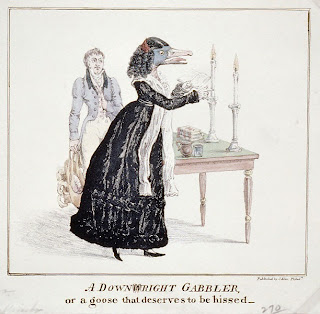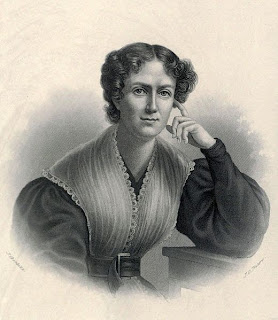After our tale of dynastic marriage and politically-motivated romance yesterday, it's time to come back down to earth and meet a women who challenged boundaries, travelling halfway across the world in search of a new life.
Fanny Wright was born in Dundee as the daughter of a wealthy political radical, James Wright, and his wife, Camilla Campbell. At the age of three Fanny was already an orphan with a hefty inheritance to support her and she moved from Scotland to live in England with another radical relative, this time an aunt. Her childhood was spent in deep education and at the age of 16 she returned to the country of her birth, where she focussed all her efforts on writing.
The borders of the United Kingdom proved too stifling for the young woman and in 1818 she and her sister set sail for the United States, where they spent two years criss-crossing the country and learning its way for themselves. All the time Fanny's political interests were deepening, leading her to develop an unshakeable belief in the principles of suffrage, education, emancipation and the rights of women to govern their own bodies.
 |
| Robert Owen, by William Henry Brooke |
Upon her return to Scotland she took up writing again and published Views of Society and Manners in America, a book that caused a sensation with its critique of American society and strong political views. Invited into radical thinking circles, Fanny returned to America, first in the company of the Marquis de Lafayette and then Robert Owen, with whom she would later found the Free Inquirer newspaper.
Travelling across the country she found herself drawn to Memphis, where she was inspired by Owen's New Harmony Commune to establish her own community, naming it the Nashoba Commune. Here she intended to provide free education to slaves so that they might find employment and opportunities once free. She sank her personal fortune into the commune, hoping to establish an egalitarian community, though she retained ownership of the slaves who resided there. Her initial plans to educate the slaves until they were able to buy their freedom was not a successful one and the commune began to haemorrhage money.
 |
| This caricature mocks Wright's lecture career, with a subservient young man holding her bonnet |
Nashoba wasn't Fanny's only interest and she spoke and wrote passionately on behalf of the working classes, gaining notoriety and respect in equal measure. She toured America again to lecture to huge audiences, inspiring devotion in her followers. However, all of this was to take its toll on her health and she was laid low by malaria. By the time she was fit to return to her position at Nashoba, the commune was on the verge of collapse. With funds running dry and sensation engulfing its free love approach, rumours of interracial relationships caused a scandal from which the commune could not recover. Fanny was forced to close Nashoba and in 1830 the 30 slaves who resided there were freed to travel under her care to Haiti.
During the journey Fanny's beloved sister, Camilla, fell ill and died. Distraught, Fanny began a relationship with a French doctor, Guillayme D'Arusmon. She fell pregnant and, mindful of the scorn that would fall on her child if born out of wedlock, married D'Arusmon. The marriage ended in divorce and Fanny found herself embroiled in a legal nightmare with her former spouse, who had legally taken control of her finances and affairs. As she fought to win back what was rightfully hers, Fanny's health began to fail and she spent more and more time living with her daughter's family.
Fanny's controversial life was to end in the winter of 1852 when she died from injuries sustained after slipping on icy ground. Today she is remembered for her passionate belief in the causes she espoused, remaining true to her ideals and principles to the end. I will leave the final words to the lady herself and the inscription carved on her tombstone.
"I have wedded the cause of human improvement, staked on it my fortune, my reputation and my life."


2 comments:
Fascinating. Though I find it quite contradictory that Fanny should campaign for the rights of the working classes but maintain ownership of her slaves. I suppose it's a symptom of the times in which she lived.
Absolutely; some of Fanny's actions do appear somewhat contradictory when viewed from 2013!
Post a Comment